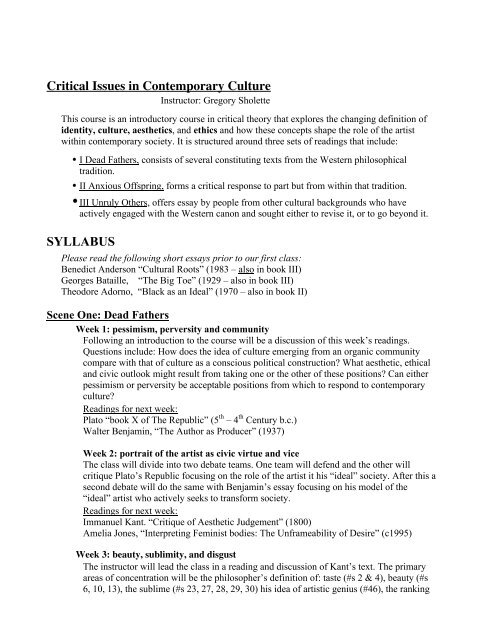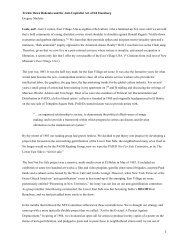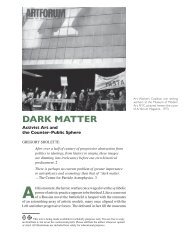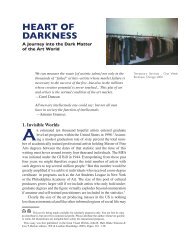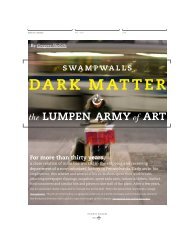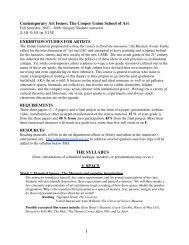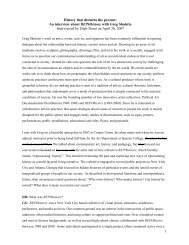Critical Issues in Contemporary Culture SYLLABUS - Gregory Sholette
Critical Issues in Contemporary Culture SYLLABUS - Gregory Sholette
Critical Issues in Contemporary Culture SYLLABUS - Gregory Sholette
Create successful ePaper yourself
Turn your PDF publications into a flip-book with our unique Google optimized e-Paper software.
<strong>Critical</strong> <strong>Issues</strong> <strong>in</strong> <strong>Contemporary</strong> <strong>Culture</strong><br />
Instructor: <strong>Gregory</strong> <strong>Sholette</strong><br />
This course is an <strong>in</strong>troductory course <strong>in</strong> critical theory that explores the chang<strong>in</strong>g def<strong>in</strong>ition of<br />
identity, culture, aesthetics, and ethics and how these concepts shape the role of the artist<br />
with<strong>in</strong> contemporary society. It is structured around three sets of read<strong>in</strong>gs that <strong>in</strong>clude:<br />
• I Dead Fathers, consists of several constitut<strong>in</strong>g texts from the Western philosophical<br />
tradition.<br />
• II Anxious Offspr<strong>in</strong>g, forms a critical response to part but from with<strong>in</strong> that tradition.<br />
• III Unruly Others, offers essay by people from other cultural backgrounds who have<br />
actively engaged with the Western canon and sought either to revise it, or to go beyond it.<br />
<strong>SYLLABUS</strong><br />
Please read the follow<strong>in</strong>g short essays prior to our first class:<br />
Benedict Anderson “Cultural Roots” (1983 – also <strong>in</strong> book III)<br />
Georges Bataille, “The Big Toe” (1929 – also <strong>in</strong> book III)<br />
Theodore Adorno, “Black as an Ideal” (1970 – also <strong>in</strong> book II)<br />
Scene One: Dead Fathers<br />
Week 1: pessimism, perversity and community<br />
Follow<strong>in</strong>g an <strong>in</strong>troduction to the course will be a discussion of this week’s read<strong>in</strong>gs.<br />
Questions <strong>in</strong>clude: How does the idea of culture emerg<strong>in</strong>g from an organic community<br />
compare with that of culture as a conscious political construction? What aesthetic, ethical<br />
and civic outlook might result from tak<strong>in</strong>g one or the other of these positions? Can either<br />
pessimism or perversity be acceptable positions from which to respond to contemporary<br />
culture?<br />
Read<strong>in</strong>gs for next week:<br />
Plato “book X of The Republic” (5 th – 4 th Century b.c.)<br />
Walter Benjam<strong>in</strong>, “The Author as Producer” (1937)<br />
Week 2: portrait of the artist as civic virtue and vice<br />
The class will divide <strong>in</strong>to two debate teams. One team will defend and the other will<br />
critique Plato’s Republic focus<strong>in</strong>g on the role of the artist it his “ideal” society. After this a<br />
second debate will do the same with Benjam<strong>in</strong>’s essay focus<strong>in</strong>g on his model of the<br />
“ideal” artist who actively seeks to transform society.<br />
Read<strong>in</strong>gs for next week:<br />
Immanuel Kant. “Critique of Aesthetic Judgement” (1800)<br />
Amelia Jones, “Interpret<strong>in</strong>g Fem<strong>in</strong>ist bodies: The Unframeability of Desire” (c1995)<br />
Week 3: beauty, sublimity, and disgust<br />
The <strong>in</strong>structor will lead the class <strong>in</strong> a read<strong>in</strong>g and discussion of Kant’s text. The primary<br />
areas of concentration will be the philosopher’s def<strong>in</strong>ition of: taste (#s 2 & 4), beauty (#s<br />
6, 10, 13), the sublime (#s 23, 27, 28, 29, 30) his idea of artistic genius (#46), the rank<strong>in</strong>g
of the arts (# 53), the role of disgust <strong>in</strong> representation (#48) and the morality of the<br />
dis<strong>in</strong>terested observer (#s 59 & #41). After the break a class member will lead us <strong>in</strong> a<br />
discussion of the Jones text accompanied by slides.<br />
Questions and themes for discussion <strong>in</strong>clude:<br />
What upsets Kant’s idea of dis<strong>in</strong>terested beauty? How and why have certa<strong>in</strong> fem<strong>in</strong>ist<br />
artists (and others) made this the aim of their art? In light of the presumed educational<br />
mission that the museum, or theater or other cultural <strong>in</strong>stitution symbolizes, should such<br />
“transgressive” work be presented to the public and if so <strong>in</strong> what context?<br />
Read<strong>in</strong>g for next week: Georg Wilhelm Friedrich Hegel, “Lecture on Aesthetics” (1818)<br />
and Edward Said, “In the Shadow of the West” (1984)<br />
Week 4: telos and tyranny<br />
The <strong>in</strong>structor will lead the class <strong>in</strong> a read<strong>in</strong>g and discussion of Hegel’s concept of<br />
dialectics, history and aesthetic progress. After the break a class member will lead <strong>in</strong> a<br />
discussion of the Said essay (with optional audio and/or visual accompaniment).<br />
Questions for debate: How does Hegel get us out of one set of problems <strong>in</strong>herited from<br />
Kant and then thrust us <strong>in</strong>to another, perhaps worse set of constra<strong>in</strong>ts? How have cultural<br />
<strong>in</strong>stitutions, sometimes quite literally, organized themselves around Hegel’s model of<br />
history? In light of Said’s critique, is it possible to re-th<strong>in</strong>k the representation between<br />
subject and object, self and other, history and progress without subsum<strong>in</strong>g one to the other<br />
and without do<strong>in</strong>g violence to the subject?<br />
The first writ<strong>in</strong>g assignment: Write a three page paper <strong>in</strong> which you use both Hegel and<br />
Said to critically “read” the collection of the Art Institute of Chicago (or local museum.)<br />
Read<strong>in</strong>gs for next week:<br />
Karl Marx, “The German Ideology” (1846 –excerpts,)<br />
Karl Marx, “Fetishism of the Commodities” (1887),<br />
Ferd<strong>in</strong>and de Sassure, “Nature of the L<strong>in</strong>guistic Sign” (1916)<br />
Roland Barthes, “The Great Family of Man” (1957)<br />
Roland Barthes, “The World of Wrestl<strong>in</strong>g” (1957)<br />
Week 5: read<strong>in</strong>gs <strong>in</strong> the real world<br />
Turn <strong>in</strong> papers. Instructor leads <strong>in</strong> a discussion of the Marx and Sassure texts. After the<br />
break a member of the class will present the Barthes essays.<br />
Questions for debate: What does Marx achieve by turn<strong>in</strong>g Hegel “on his head”? Does the<br />
concept of commodity fetishism apply to the arts, if so how, if not why not? Is the science<br />
of signs proposed by Sassure and employed by Barthes a useful technique for <strong>in</strong>terpret<strong>in</strong>g<br />
and present<strong>in</strong>g art to the public? Or is it useful only to other academics? Imag<strong>in</strong>e Sassure’s<br />
and Marx’s ideas comb<strong>in</strong>ed. What strengths and limitations do you see <strong>in</strong> these methods<br />
for <strong>in</strong>terpret<strong>in</strong>g art and culture and what sort of cultural <strong>in</strong>stitution might they produce?<br />
Read<strong>in</strong>g for next week:<br />
Sigmund Freud, “The Dream Work” (1916)
Jacques Lacan, “The Mirror Stage as Formative of the Function of<br />
the I as Revealed <strong>in</strong> Psychoanalytic Experience: (1949)<br />
Louis Althusser, “Ideology and Ideological State Apparatuses” (1970)<br />
Scene Two: Anxious Offspr<strong>in</strong>g<br />
Week 6: ethics and power<br />
Return of papers.<br />
The <strong>in</strong>structor leads class <strong>in</strong> a read<strong>in</strong>g and discussion of the Freud and Lacan texts. After<br />
the break a member of the class will lead <strong>in</strong> a discussion of the Althusser essay.<br />
Questions for discussion:<br />
If we agree with Freud, Lacan and Althusser (follow<strong>in</strong>g Marx) that our understand<strong>in</strong>g of<br />
the world is always first processed by the social <strong>in</strong>stitutions of language and<br />
representation, then is mean<strong>in</strong>g decided <strong>in</strong> the last <strong>in</strong>stance by those with the most<br />
<strong>in</strong>stitutional power? If this premise is true, how does an arts adm<strong>in</strong>istrator def<strong>in</strong>e and<br />
ma<strong>in</strong>ta<strong>in</strong> her ethics when power, not truth or beauty, is the actual medium of cultural<br />
<strong>in</strong>stitutions? How does one devise an ethical work<strong>in</strong>g relationship serv<strong>in</strong>g oftenconflict<strong>in</strong>g<br />
needs of artists, funders, staff, board members, and the public?<br />
Second writ<strong>in</strong>g assignment: If identity is founded on loss and misrecognition as Lacan<br />
argues, what does this suggest regard<strong>in</strong>g the traditional mission of most cultural<br />
<strong>in</strong>stitutions? What might a museum, theater or archive based on the theories of Freud and<br />
Lacan look like? (The use of visuals is permitted with this assignment.)<br />
Read<strong>in</strong>gs for next week: Mikhail Bakht<strong>in</strong>, “Laughter and Freedom” (1940)<br />
Roland Barthes, “Death of the Author” (1968)<br />
Jacques Derrida “Structure, Sign and Play <strong>in</strong> the Discourse of the Human Sciences” (1966)<br />
Week 7: is freedom just another word?<br />
Turn <strong>in</strong> papers. A member of the class will lead <strong>in</strong> the discussion of the Bakht<strong>in</strong> and<br />
Barthes essays, and after the break a second student leads the discussion of Derrida text.<br />
Questions for debate: These texts concern the open<strong>in</strong>g-up of mean<strong>in</strong>g and authority to<br />
multiple read<strong>in</strong>gs, some of which contradict the <strong>in</strong>tent of an author. If we agree with these<br />
authors that liberation and play are connected, what possible implications does such<br />
“deconstruction” of authorial <strong>in</strong>tentions hold for cultural adm<strong>in</strong>istrators and <strong>in</strong>stitutions<br />
that typically symbolize serious, cultural authority? How do the different notions of<br />
liberation, play and laughter proposed by Bathes, Bakht<strong>in</strong> and Derrida agree and where<br />
do they differ? How important is the idea of freedom to contemporary society and what<br />
should <strong>in</strong>stitutions do if anyth<strong>in</strong>g to respond to this need or its lack? Is there such a th<strong>in</strong>g<br />
as an alternative or counter-<strong>in</strong>stitutional space?<br />
Read<strong>in</strong>g for next week: Walter Benjam<strong>in</strong>, “Art <strong>in</strong> the Age of Mechanical Reproduction”<br />
(1936)
Week 8: revolutioniz<strong>in</strong>g art production<br />
Return of papers Instructor leads <strong>in</strong> a read<strong>in</strong>g of the Benjam<strong>in</strong> text.<br />
After the break the class will form two debate teams.<br />
Prior to the end of class all assignments for the f<strong>in</strong>al paper are determ<strong>in</strong>ed and student<br />
progress is reviewed.<br />
Some questions for debate: Benjam<strong>in</strong> proposes that modern imag<strong>in</strong>g technology has<br />
dethroned the unique status of the traditional art object. He argues that all art is tied to<br />
politics and that people who engage with culture must choose to either make this fact<br />
transparent or to mystify this l<strong>in</strong>k while explor<strong>in</strong>g the form of production culture takes <strong>in</strong><br />
the process. Is this a viable position today? The class will divide <strong>in</strong>to two groups and<br />
us<strong>in</strong>g your own experience and words one half will defend and the other half challenge<br />
this assertion with the <strong>in</strong>structor act<strong>in</strong>g as mediator.<br />
Read<strong>in</strong>gs for next week:<br />
Clemet Greenberg, “Modernist Pa<strong>in</strong>t<strong>in</strong>g” (1963)<br />
Fredric Jameson, “Postmodernism and Consumer Society” (1982)<br />
Week 9: modernism and after<br />
A member of the class leads <strong>in</strong> a discussion of the Greenberg essay (with slides) and the<br />
<strong>in</strong>structor leads <strong>in</strong> a read<strong>in</strong>g and discussion of the Jameson text.<br />
Questions for discussion:<br />
From Kant to Greenberg, the autonomy of art from popular culture, politics, and society<br />
has been a central feature of western aesthetics and <strong>in</strong>stitutions. But if we accept<br />
Jameson’s description of the post-modernist era, what has been ga<strong>in</strong>ed and what lost <strong>in</strong><br />
terms of aesthetics and cultural identity? What changes <strong>in</strong> art <strong>in</strong>stitutions have grown out<br />
of this paradigm shift? How might one manage the presentation and management of a<br />
post-modern culture and what does it imply <strong>in</strong> terms of the artist and the public for art <strong>in</strong><br />
the years ahead?<br />
Third writ<strong>in</strong>g assignment: Describe <strong>in</strong> your own terms and us<strong>in</strong>g your own examples the<br />
shift from a modernist to post-modern aesthetic. Give examples of what appears<br />
consistent and what seems different between the two outlooks. Conclude your paper by<br />
comment<strong>in</strong>g on the way a post-modern outlook might affect your career.<br />
Read<strong>in</strong>gs for next week: Terry Eagleton, “From the Polis to Postmodernism” <strong>in</strong> The<br />
Ideology of the Aesthetic (1990),<br />
Dick Hebdige, “Introduction: Subculture and Style” and “From <strong>Culture</strong> to Hegemony”<br />
<strong>in</strong> Subculture: The Mean<strong>in</strong>g of Style (1979)
Week 10, November 2: new paradigms<br />
Turn <strong>in</strong> papers.The <strong>in</strong>structor leads <strong>in</strong> a read<strong>in</strong>g of the Eagleton essay as well as<br />
summariz<strong>in</strong>g the key themes discussed <strong>in</strong> the class up to now. After the break a member of<br />
the class leads <strong>in</strong> a discussion of the Hebdige essay.<br />
A screen<strong>in</strong>g of excerpts from Chris Marker’s film Sans Soleil.<br />
Read<strong>in</strong>gs for next week: Franz Fanon, “The Fact of Blackness” (1952)<br />
Staurt Hall, New Ethnicities (1989)<br />
Henry Louis Gates, Jr. “The Black Man’s Burden” (1993)<br />
Scene Three: Unruly Others<br />
Week 11: identities <strong>in</strong> crisis<br />
Return of papers. A member of the class will lead <strong>in</strong> the read<strong>in</strong>g and discussion of the Fanon text.<br />
Another will leads <strong>in</strong> the discussion of the Hall essay and a third <strong>in</strong> the Gates Jr. text.<br />
Questions for discussion: The writers argue that one’s sense of identity and social status is<br />
affected by the way they appear to others, but <strong>in</strong> an ideal, democratic society should such<br />
differences be taken <strong>in</strong>to account? Is there such a th<strong>in</strong>g as “color bl<strong>in</strong>d” cast<strong>in</strong>g for example? And<br />
if identity is not natural but is <strong>in</strong>stead formed by culture should special exhibitions, programs, and<br />
even museums be devoted to people of a particular race, gender, or sexual orientation? By the<br />
same token, should the k<strong>in</strong>ds of artwork, writ<strong>in</strong>g, music and theater one presents as an arts<br />
adm<strong>in</strong>istrator (or <strong>in</strong>structor) reflect a broader idea of culture or cultures?<br />
Read<strong>in</strong>gs for next week: Homi K. Bhabha, “Signs Taken for Wonders” (1985)<br />
T<strong>in</strong>h T. M<strong>in</strong>h-ha, “No Master Territories” (1991)<br />
Fourth writ<strong>in</strong>g assignment: Debate the pros and cons of a class, race and gender-neutral aesthetic<br />
outlook as the mission of a contemporary cultural <strong>in</strong>stitution. Use at least one specific example<br />
selected from experience or a recent news event.<br />
Week 12: hybrid selves<br />
Turn <strong>in</strong> papers. The <strong>in</strong>structor will lead <strong>in</strong> a read<strong>in</strong>g and discussion of the Bhabha text. After the<br />
break a member of the class will lead <strong>in</strong> a read<strong>in</strong>g and discussion of the M<strong>in</strong>h-ha text and her film<br />
“Liv<strong>in</strong>g <strong>in</strong> the Round”<br />
Questions for debate: By apply<strong>in</strong>g post-structuralist theories to the image of the colonial subject<br />
Bhabha and M<strong>in</strong>h-ha open-up identity (like a text) to multiple read<strong>in</strong>gs, but who is affected by<br />
this revised notion of subjectivity? How might this hybrid identity respond to actual prejudice on<br />
the job and <strong>in</strong> public life? What implications might this idea have for chang<strong>in</strong>g the practices of<br />
cultural <strong>in</strong>stitutions?
Read<strong>in</strong>gs for next week: Michel Foucault, “Panopticism” from Discipl<strong>in</strong>e and Punish (1975)<br />
Gilles Deleuze, “Postscript on the Societies of Control” (1990)<br />
Week 13: more pessimism?<br />
Return of papers. A member of the class leads <strong>in</strong> a read<strong>in</strong>g of the Foucault essay (with visuals).<br />
The <strong>in</strong>structor leads class <strong>in</strong> a read<strong>in</strong>g and discussion of the Deleuze essay. The class will then<br />
break <strong>in</strong>to two debat<strong>in</strong>g teams.<br />
Questions for debate: Defend and critique the similarity and differences that cultural <strong>in</strong>stitutions,<br />
such as museums, television, theater and universities, share with the models of human<br />
consciousness and society presented by Foucault and Deleuze. Is it possible to th<strong>in</strong>k or act outside<br />
the society of discipl<strong>in</strong>e? How about outside or aga<strong>in</strong>st the society of control? Assum<strong>in</strong>g escape<br />
from these <strong>in</strong>stitutional frameworks is conceivable at all do you ignore, nurture, or elim<strong>in</strong>ate this<br />
other, and what are the implications of each position?<br />
Read<strong>in</strong>gs for next week: Gayatri Chakravorty Spivak, “Can the Subaltern Speak?” (1988) Gayatri<br />
Chakravorty Spivak, “Postmarked Clacutta, India” (<strong>in</strong>terview: 1987)<br />
Cathy Griggers, “Lesbian Bodies <strong>in</strong> the Age of (Post) mechanical Reproduction (1994)<br />
Week 14: speak<strong>in</strong>g out loud<br />
Members of the class lead <strong>in</strong> a read<strong>in</strong>g of the Griggers and Spivak essays.<br />
Questions for debate: How have fem<strong>in</strong>ist artists, writers and activists used critical theory to devise<br />
new political and aesthetic practices? What implications might these positions have for devis<strong>in</strong>g<br />
new <strong>in</strong>stitutions for the presentation of art? How about for modify<strong>in</strong>g exist<strong>in</strong>g <strong>in</strong>stitutions?<br />
Read<strong>in</strong>gs for f<strong>in</strong>al week: Georges Bataille, “The Notion of Expenditure” (1933)<br />
Gilles Deleuze, “ Rhizome Versus Trees” from A Thousand Plateaus: Capitalism<br />
¨ and Schizophrenia (1987)<br />
Dave Hickey, “Noth<strong>in</strong>g Like the Son: on Robert Mapplethorpe’s X Portfolio” (1995)<br />
Week 15: f<strong>in</strong>al thoughts on beauty, society, and hope<br />
Members of the class lead <strong>in</strong> a read<strong>in</strong>g and discussion of the Bataille, the Hickey and Deluze<br />
essays.<br />
Questions for discussion: Where does the responsibility of the arts adm<strong>in</strong>istrator lie? Is it with the<br />
artist <strong>in</strong>clud<strong>in</strong>g those who denounce all concerns with social <strong>in</strong>stitutions by liv<strong>in</strong>g and sometimes<br />
dy<strong>in</strong>g for their work? Or is it as a mediator of different social spheres and publics? What role<br />
should beauty, ethics, and power play <strong>in</strong> these considerations? What alternatives can one envision<br />
to the present <strong>in</strong>stitutional system if any?<br />
Week 16, 12/14: student presentations<br />
• Note: Several useful glossaries of theory-related terms can be found today <strong>in</strong>clud<strong>in</strong>g one <strong>in</strong> the<br />
book Art History and its Methods: a <strong>Critical</strong> Anthology edited by Eric Fernie.(Phaidon Press:<br />
London 1995.) There is also a book entitled Artspeak that has another useful glossary.
I The Dead Fathers<br />
Plato, “The Republic” (5 th – 4 th Century b.c.)<br />
Immanuel Kant. “Critique of Aesthetic Judgement” (1800)<br />
Georg Wilhelm Friedrich Hegel, “Lecture on Aesthetics” (1818)<br />
Karl Marx, “The German Ideology” (1846)<br />
Karl Marx, “Fetishism of Commodity” (1887)<br />
Sigmund Freud, “The Dream Work” (1916)<br />
Ferd<strong>in</strong>and de Sassure, “Nature of the L<strong>in</strong>guistic Sign” (1916)<br />
II Anxious Offspr<strong>in</strong>g<br />
Walter Benjam<strong>in</strong>, “Art <strong>in</strong> the Age of Mechanical Reproduction” (1936)<br />
Walter Benjam<strong>in</strong>, “The Author as Producer” (1937)<br />
Mikhail Bakht<strong>in</strong>, “Laughter and Freedom” (1940)<br />
Jacques Lacan, “The Mirror Stage as Formative of the Function of<br />
the I as Revealed <strong>in</strong> Psychoanalytic Experience: (1949)<br />
Roland Barthes, “The Great Family of Man” (1957)<br />
Roland Barthes, “The World of Wrestl<strong>in</strong>g” (1957)<br />
Roland Barthes, “Death of the Author” (1968)<br />
Jacques Derrida “Structure, Sign and Play <strong>in</strong> the Discourse of the Human Sciences” (1966)<br />
Clemet Greenberg, “Modernist Pa<strong>in</strong>t<strong>in</strong>g” (1963)<br />
Louis Althusser, “Ideology and Ideological State Apparatuses” (1970)<br />
Theodore Adorno, “Black as an Ideal” (1970)<br />
Michel Foucault, “Panopticism” from Discipl<strong>in</strong>e and Punish (1975)<br />
Gilles Deleuze, “Postscript on the Societies of Control” (1990)<br />
Dick Hebdige, “Introduction: Subculture and Style” and<br />
“From <strong>Culture</strong> to Hegemony” <strong>in</strong> Subculture: The Mean<strong>in</strong>g of Style (1979)<br />
Fredric Jameson, “Postmodernism and Consumer Society” (1982)<br />
Terry Eagleton, “From the Polis to Postmodernism” <strong>in</strong><br />
The Ideology of the Aesthetic (1990)<br />
III Unruly Others<br />
Franz Fanon, “The Fact of Blackness” (1952)<br />
Edward Said, “In the Shadow of the West” (1984)<br />
Henry Louis Gates, Jr. “The Black Man’s Burden” (1993)<br />
Staurt Hall, New Ethnicities (1989)<br />
Cathy Griggers, “Lesbian Bodies <strong>in</strong> th eAge of (Post)mechanical Reproduction (1994)<br />
Amelia Jones, “Interpret<strong>in</strong>g Fem<strong>in</strong>ist bodies: The Unframeability of Desire” (c1995)<br />
Dave Hickey, “Noth<strong>in</strong>g Like the Son: on Robert Mapplethorpe’s X Portfolio” (1995)<br />
Gayatri Chakravorty Spivak, “Postmarked Clacutta, India” (<strong>in</strong>terview: 1987)<br />
Gayatri Chakravorty Spivak, “Can the Subaltern Speak?” (1988)<br />
Homi K. Bhabha, “Signs Taken for Wonders” (1985)<br />
T<strong>in</strong>h T. M<strong>in</strong>h-ha, “No Master Territories” (1991)<br />
Benedict Anderson “Cultural Roots” from Imag<strong>in</strong>ed Communities: Reflections on
the Orig<strong>in</strong> and Spread of Nationalism (1983)<br />
Georges Bataille, “The Big Toe” (1929)<br />
Georges Bataille, “The Notion of Expenditure” (1933)<br />
Gilles Deleuze, “ Rhizome Versus Trees” from A Thousand Plateaus: Capitalism<br />
and Schizophrenia (1987)


